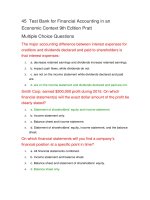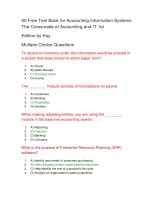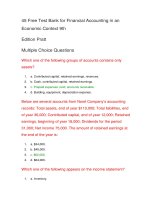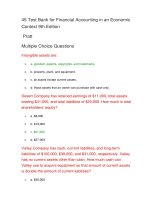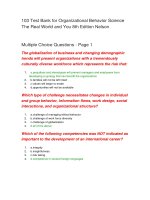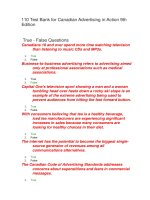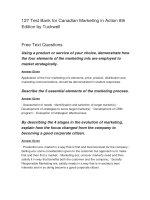test bank for macroeconomics canada in the global be0effe2fec97562d0ceb687020d9df6
Bạn đang xem bản rút gọn của tài liệu. Xem và tải ngay bản đầy đủ của tài liệu tại đây (517.58 KB, 76 trang )
Parkin/Bade, Economics: Canada in the Global Environment, 8e
Chapter 1 What Is Economics?
1.1 Definition of Economics
1) In a world characterized by scarcity
A) all goods are free.
B) opportunity cost is zero.
C) we are not limited by time.
D) individuals need not work to obtain goods.
E) people must make choices among alternatives.
Answer: E
Diff: 1 Type: MC
Topic: Definition of Economics
2) Which of the following is the best definition of economics?
A) the study of how a provincial government allocates tax dollars
B) the study of how consumers spend their income
C) the study of how producers decide what inputs to hire and what outputs to produce
D) the study of how individuals, businesses, governments, and entire societies make choices as
they cope with scarcity and the incentives that influence and reconcile those choices
E) the study of how consumers and producers meet each other at the market
Answer: D
Diff: 1 Type: MC
Topic: Definition of Economics
3) Which of the following is a microeconomic topic?
A) the reasons why a consumer buys less honey
B) the reasons why the average price level in a country falls
C) the cause of increasing unemployment
D) the effect of the government budget deficit on inflation
E) the reasons why the labour force in a country decreases
Answer: A
Diff: 1 Type: MC
Topic: Definition of Economics
4) The study of how wages are set for New Brunswick teachers is classified as
A) a macroeconomic topic.
B) a microeconomic topic.
C) economics of social interest.
D) economics of private interest.
E) normative economics.
Answer: B
Diff: 1 Type: MC
Topic: Definition of Economics
Copyright © 2013 Pearson Canada Inc.
1
Parkin/Bade, Economics: Canada in the Global Environment, 8e
5) Which of the following newspaper headlines concerns a macroeconomic issue?
A) Why are people buying more SUVs and fewer minivans?
B) How would a tax on e-commerce affect chapters.indigo.ca?
C) How would an unexpected freeze in Oxford, Nova Scotia change the price of blueberries in
the Maritimes?
D) Why is Japan's economy stagnant?
E) Why do grain producers purchase less pesticides?
Answer: D
Diff: 1 Type: MC
Topic: Definition of Economics
6) The branch of economics that studies the choices of individuals and businesses is
A) macroeconomics.
B) microeconomics.
C) positive economics.
D) normative economics.
E) social economics.
Answer: B
Diff: 1 Type: MC
Topic: Definition of Economics
Source: Study Guide
7) Each of the following would be considered a macroeconomic topic except
A) the reasons for a decrease in the unemployment rate.
B) the cause of recessions.
C) the effect of the government budget deficit on inflation.
D) the determination of aggregate income.
E) the selection of production techniques.
Answer: E
Diff: 2 Type: MC
Topic: Definition of Economics
8) Complete the following sentence. Macroeconomics
A) is primarily concerned with the operation of individual markets in the economy.
B) deals mainly with the economic behaviour of households.
C) is the only part of economics to deal with government decisions.
D) is primarily concerned with the behaviour of the stock market.
E) is the study of the national economy and the global economy.
Answer: E
Diff: 2 Type: MC
Topic: Definition of Economics
Copyright © 2013 Pearson Canada Inc.
2
Parkin/Bade, Economics: Canada in the Global Environment, 8e
9) The determination of prices in individual markets is primarily a concern of
A) positive economics.
B) negative economics.
C) macroeconomics.
D) microeconomics.
E) descriptive economics.
Answer: D
Diff: 2 Type: MC
Topic: Definition of Economics
10) Which one of the following topics does macroeconomics study?
A) decisions of individual firms
B) effects of government safety regulations on the price of cars
C) the performance of the global economy
D) prices of individual goods and services
E) effects of taxes on the price of gasoline
Answer: C
Diff: 2 Type: MC
Topic: Definition of Economics
11) Which one of the following topics does microeconomics study?
A) reasons for a fall in the price of orange juice
B) the effect of a rise in the Canadian dollar on Canada's exports
C) effect of interest rates on national economic growth
D) effect of the government budget deficit on employment
E) determination of total production in a country
Answer: A
Diff: 2 Type: MC
Topic: Definition of Economics
12) Complete the following sentence. Microeconomics is
A) not concerned with factors of production.
B) concerned with normative issues only.
C) concerned with the size of the total amount of income earned by all households in an
economy.
D) the branch of economics that studies the choices of individuals and businesses.
E) concerned exclusively with the role of the government in the economy.
Answer: D
Diff: 2 Type: MC
Topic: Definition of Economics
Copyright © 2013 Pearson Canada Inc.
3
Parkin/Bade, Economics: Canada in the Global Environment, 8e
13) Which of the following would be considered a microeconomic topic?
A) the severity of a recession
B) the cause of unemployment in the economy
C) the effect of the government budget deficit on inflation
D) the determination of aggregate income
E) the study of how wages are set for mine workers
Answer: E
Diff: 2 Type: MC
Topic: Definition of Economics
14) The branch of economics that studies the national economy and the global economy is
A) macroeconomics.
B) microeconomics.
C) Keynesian economics.
D) positive economics.
E) normative economics.
Answer: A
Diff: 1 Type: MC
Topic: Definition of Economics
15) The fact that human wants cannot be fully satisfied with available resources is called the
problem of
A) opportunity cost.
B) scarcity.
C) normative economics.
D) marginal cost.
E) the big tradeoff.
Answer: B
Diff: 1 Type: MC
Topic: Definition of Economics
16) The problem of scarcity exists
A) only in economies that lack incentives.
B) only in economies that have incentives.
C) in all economies.
D) only when people are unemployed.
E) now but will be eliminated with economic growth.
Answer: C
Diff: 2 Type: MC
Topic: Definition of Economics
Copyright © 2013 Pearson Canada Inc.
4
Parkin/Bade, Economics: Canada in the Global Environment, 8e
17) The inescapable economic fact is that
A) there are unlimited wants and limited resources.
B) there are unlimited resources, and we just have to figure out how to allocate them.
C) capitalists are always exploiting the workers.
D) unions are always exploiting firms.
E) capitalists and unions cannot work together.
Answer: A
Diff: 2 Type: MC
Topic: Definition of Economics
18) An incentive ________.
A) could be a reward but could not be a penalty
B) could be a penalty but could not be a reward
C) could be either a reward or a penalty
D) is the opposite of a tradeoff
E) occurs in the macroeconomy but not in the microeconomy
Answer: C
Type: MC
19) Scarcity confronts ________.
A) neither the poor nor the rich
B) the rich but not the poor
C) the poor but not the rich
D) the rich and the poor
E) families with incomes less than $25,000 a year
Answer: D
Type: MC
Copyright © 2013 Pearson Canada Inc.
5
Parkin/Bade, Economics: Canada in the Global Environment, 8e
1.2 Two Big Economic Questions
1) The two big economic questions
A) involve self-interest only.
B) involve only social interest.
C) involve neither self-interest nor social interest.
D) do not arise from scarcity.
E) involve both self-interest and social interest.
Answer: E
Diff: 1 Type: MC
Topic: Two Big Economic Questions
2) The two big economic questions
A) summarize the scope of economics.
B) are "what goods and services are produced?" and "how are goods and services produced?"
C) have nothing to do with goods and services.
D) do not consider for whom goods and services are produced.
E) have nothing to do with the way goods and services are produced.
Answer: A
Diff: 1 Type: MC
Topic: Two Big Economic Questions
3) The two big economic questions include all of the following except
A) what to produce.
B) why to produce.
C) how to produce.
D) for whom to produce.
E) can choices made in the pursuit of self-interest also promote the social interest.
Answer: B
Diff: 2 Type: MC
Topic: Two Big Economic Questions
4) When a firm decides to produce more hybrid cars and fewer gas guzzlers, it is answering the
________ question.
A) "how"
B) "what"
C) "who"
D) "where"
E) "when"
Answer: B
Diff: 2 Type: MC
Topic: Two Big Economic Questions
Copyright © 2013 Pearson Canada Inc.
6
Parkin/Bade, Economics: Canada in the Global Environment, 8e
5) When a textile firm decides to produce more silk fabric and less cotton fabric, it is answering
the ________ question.
A) "who"
B) "how"
C) "what"
D) "where"
E) "when"
Answer: C
Diff: 2 Type: MC
Topic: Two Big Economic Questions
6) When a farmer decides to harvest tomatoes using machines instead of migrant workers, the
farmer is answering the ________ question.
A) "what"
B) "how"
C) "who"
D) "where"
E) "when"
Answer: B
Diff: 2 Type: MC
Topic: Two Big Economic Questions
7) Complete the following sentence. Capital is
A) money in the bank.
B) "gifts of nature."
C) tools, instruments, machines, buildings, and other constructions that businesses use to produce
goods and services.
D) land.
E) stocks and bonds.
Answer: C
Diff: 1 Type: MC
Topic: Two Big Economic Questions
8) When a firm decides to produce computers using robots instead of people, it is answering the
________ question.
A) "what"
B) "where"
C) "how"
D) "who"
E) "when"
Answer: C
Diff: 2 Type: MC
Topic: Two Big Economic Questions
Copyright © 2013 Pearson Canada Inc.
7
Parkin/Bade, Economics: Canada in the Global Environment, 8e
9) To meet increased demand for its good, a firm decides to hire a few high-skilled workers,
rather than hire many low-skilled workers. The firm is answering the ________ question.
A) "when"
B) "what"
C) "who"
D) "where"
E) "how"
Answer: E
Diff: 2 Type: MC
Topic: Two Big Economic Questions
10) An art museum decides to offer tours by having visitors listen to CDs rather than have tour
guides. The museum is answering the ________ question.
A) "what"
B) "who"
C) "how"
D) "where"
E) "when"
Answer: C
Diff: 2 Type: MC
Topic: Two Big Economic Questions
11) To earn income, people sell the services of the factors of production they own. Land earns
________; labour earns ________; capital earns ________ and entrepreneurship earns
________.
A) profit; wages; rent; interest
B) wages; interest; profit; rent
C) rent; wages; interest; profit
D) profit; interest; wages; rent
E) interest; profit; rent; wages
Answer: C
Diff: 2 Type: MC
Topic: Two Big Economic Questions
12) The fact that some people can afford to live in beautiful homes while others are homeless is
an example of an economy facing the ________ question.
A) "what"
B) "how"
C) "for whom"
D) "where"
E) "when"
Answer: C
Diff: 2 Type: MC
Topic: Two Big Economic Questions
Copyright © 2013 Pearson Canada Inc.
8
Parkin/Bade, Economics: Canada in the Global Environment, 8e
13) The fact that a hockey star earns $3 million a year while a teacher earns $50,000 annually is
an example of an economy facing the ________ question.
A) "what"
B) "how"
C) "where"
D) "for whom"
E) "when"
Answer: D
Diff: 2 Type: MC
Topic: Two Big Economic Questions
14) Complete the following sentence. Entrepreneurship is
A) defined as money.
B) traded on the stock market.
C) categorized as capital.
D) the human resource that organizes labour, land and capital.
E) categorized as the factor of production labour.
Answer: D
Diff: 2 Type: MC
Topic: Two Big Economic Questions
15) Sue, who has a law degree, earns $200,000 a year, while Chris, a high-school dropout, earns
$5.00 an hour. This is an example of an economy facing the ________ question.
A) "what"
B) "how"
C) "for whom"
D) "where"
E) "when"
Answer: C
Diff: 2 Type: MC
Topic: Two Big Economic Questions
16) A star athlete can afford a garage full of exotic cars while other people can only afford to take
a city bus for transportation. This is an example of an economy facing the ________ question.
A) "what"
B) "how"
C) "for whom"
D) "where"
E) "when"
Answer: C
Diff: 2 Type: MC
Topic: Two Big Economic Questions
Copyright © 2013 Pearson Canada Inc.
9
Parkin/Bade, Economics: Canada in the Global Environment, 8e
17) Complete the following sentence. Financial capital is
A) one of the "gifts of nature."
B) the tools and machines that are used to produce goods and services.
C) money, stocks, and bonds.
D) used in the production of goods and services.
E) land.
Answer: C
Diff: 1 Type: MC
Topic: Two Big Economic Questions
18) Which factor of production earns the most income?
A) capital
B) land
C) labour
D) entrepreneurship
E) the stock market
Answer: C
Diff: 2 Type: MC
Topic: Two Big Economic Questions
19) What choices are best for the entire society?
A) self-interest choices
B) minority group choices
C) social interest choices
D) ethnic group choices
E) regional interest choices
Answer: C
Diff: 1 Type: MC
Topic: Two Big Economic Questions
20) Self-interest choices are
A) those choices which are best for the person making them.
B) never in the social interest.
C) always in the social interest.
D) those choices that are best for all residents of a region.
E) choices that are agreed to by majority vote.
Answer: A
Diff: 3 Type: MC
Topic: Two Big Economic Questions
Copyright © 2013 Pearson Canada Inc.
10
Parkin/Bade, Economics: Canada in the Global Environment, 8e
21) The expansion of international trade, borrowing and lending, and investment is
A) the big tradeoff.
B) industrial revolution.
C) corporate revolution.
D) globalization.
E) antiglobalization.
Answer: D
Diff: 3 Type: MC
Topic: Two Big Economic Questions
22) Which of the following relates factors of production to the sources of income correctly?
A) Land earns interest.
B) Land earns rent.
C) Labour earns rent.
D) Capital earns profit.
E) Entrepreneurship earns rent.
Answer: B
Diff: 1 Type: MC
Topic: Two Big Economic Questions
23) Which statement about incomes earned by factors of production is false?
A) Land earns rent.
B) Natural resources earn rent.
C) Labour earns wages.
D) Capital earns profit.
E) Entrepreneurship earns profit.
Answer: D
Diff: 1 Type: MC
Topic: Two Big Economic Questions
24) A tractor is an example of which of the following factors of production?
A) capital
B) labour
C) land
D) entrepreneurship
E) energy
Answer: A
Diff: 1 Type: MC
Topic: Two Big Economic Questions
Copyright © 2013 Pearson Canada Inc.
11
Parkin/Bade, Economics: Canada in the Global Environment, 8e
25) Which one of the following is an example of capital as a factor of production?
A) money held by Tim Hortons
B) a Bell Canada bond
C) an automobile factory owned by Ford
D) a high school teacher
E) natural gas
Answer: C
Diff: 1 Type: MC
Topic: Two Big Economic Questions
26) Which of the following would an economist classify as capital?
A) natural resources
B) a deposit of silver
C) entrepreneurship
D) a computer
E) land
Answer: D
Diff: 1 Type: MC
Topic: Two Big Economic Questions
27) Which one of the following is labour?
A) money
B) a carpenter's hammer
C) a shoe factory
D) a bread-slicing machine
E) a singer's voice
Answer: E
Diff: 1 Type: MC
Topic: Two Big Economic Questions
28) Which one of the following would economists classify as land?
A) an automotive plant in British Columbia
B) rich agricultural soil in Saskatchewan
C) an oil rig in the Atlantic Ocean
D) an elementary school in Nova Scotia
E) automobiles parked in a parking lot in Manitoba
Answer: B
Diff: 2 Type: MC
Topic: Two Big Economic Questions
Copyright © 2013 Pearson Canada Inc.
12
Parkin/Bade, Economics: Canada in the Global Environment, 8e
29) Which one of the following is an example of land?
A) Bono's singing voice
B) a computer program
C) Lake Erie
D) a road
E) a dam
Answer: C
Diff: 1 Type: MC
Topic: Two Big Economic Questions
30) Which one of the following is an example of a factor of production?
A) an insurance policy
B) a donut
C) the skills of a welder
D) an IBM stock certificate
E) a computer game
Answer: C
Diff: 1 Type: MC
Topic: Two Big Economic Questions
31) Which one of the following is an example of capital?
A) money
B) a carpenter
C) pasture
D) a bread-slicing machine
E) a university professor
Answer: D
Diff: 1 Type: MC
Topic: Two Big Economic Questions
32) The creation of a successful movie illustrates choices made in self-interest that also achieve
the social interest if ________.
A) the movie has a higher attendance than any other movie produced that year
B) the movie is produced at the lowest possible cost, and the movie gives the greatest possible
benefit
C) the movie addresses a social issue
D) the movie is an Academy award winner because an Academy award winning movie is most
popular with the movie-going public
E) the movie is produced in a country where workers typically earn less than workers in North
America
Answer: B
Diff: 1 Type: MC
Topic: Two Big Economic Questions
Source: MyEconLab
Copyright © 2013 Pearson Canada Inc.
13
Parkin/Bade, Economics: Canada in the Global Environment, 8e
33) The creation of a successful movie can influence the main questions that economics seeks to
answer. Choose the statement that is false.
A) The movie influences the how question because the movie can create new production
techniques, which can be used in subsequent films.
B) The movie influences the for whom question because the people who earn higher incomes
through the movie production buy more goods and services.
C) The movie influences the when question because movie crews work on many different films
and must be available for the entire production.
D) The movie influences the what question because it can lead to spinoff goods or a new movie
genre, which can result in the production of similar films.
E) The movie influences the how question because it can use unknown actors or Academy Award
winners.
Answer: C
Diff: 1 Type: MC
Topic: Two Big Economic Questions
Source: MyEconLab
34) Choose the correct statement.
A) Canada produces more services than goods.
B) Canada produces more goods than services.
C) Canada produces an equal quantity of goods and services.
D) China's production of services is a greater percentage of its total production than Canada's.
E) Canada's production of manufacturing is a greater percentage of its total production than
China's.
Answer: A
Type: MC
35) In Canada ________ percent of the adult population have completed high school and
________ percent have a university degree.
A) 23; 93
B) 93; 53
C) 93; 23
D) 100; 53
E) 53; 23
Answer: C
Type: MC
36) Which of the following is not a factor of production?
A) the water used to cool a nuclear power plant
B) the effort of farmers raising cattle
C) the wages paid to workers
D) the management skill of a small business owner
E) the land used by a farmer to grow wheat
Answer: C
Type: MC
Copyright © 2013 Pearson Canada Inc.
14
Parkin/Bade, Economics: Canada in the Global Environment, 8e
1.3 The Economic Way of Thinking
1) Opportunity cost is
A) the value of your favourite activity.
B) your value of leisure.
C) the money you spend on food, shelter, and clothing.
D) the marginal benefit from an activity.
E) the highest-valued alternative that we give up to get something.
Answer: E
Diff: 2 Type: MC
Topic: The Economic Way of Thinking
2) During the next hour John can choose one of the following three activities: playing basketball,
watching television, or reading a book. The opportunity cost of reading a book
A) depends on how much the book cost when it was purchased.
B) is the value of playing basketball if John prefers that to watching television.
C) is the value of playing basketball and the value of watching television.
D) depends on how much John enjoys the book.
E) is the value of watching television if John prefers playing basketball to watching television.
Answer: B
Diff: 3 Type: MC
Topic: The Economic Way of Thinking
3) Sally has to decide whether to study for her economics test or her accounting test. If she
chooses to study for accounting, her opportunity cost of studying accounting is
A) studying economics.
B) less than the value of studying economics.
C) not comparable to the value of studying economics.
D) equal to the value of studying economics.
E) the future lost wages that will occur if she fails her accounting exam.
Answer: A
Diff: 2 Type: MC
Topic: The Economic Way of Thinking
4) When the government of Alberta chooses to build more roads, the required resources are no
longer available to provide better health care facilities. This situation illustrates the concept of
A) marginal benefit.
B) monetary cost.
C) opportunity cost.
D) human capital.
E) entrepreneurship.
Answer: C
Type: MC
Topic: The Economic Way of Thinking
Copyright © 2013 Pearson Canada Inc.
15
Parkin/Bade, Economics: Canada in the Global Environment, 8e
5) The concept of opportunity cost
A) is relevant only for European countries.
B) suggests that individuals can achieve all they want.
C) suggests a major increase in public education spending means a reduced expansion in the
public healthcare system.
D) is relevant only for developed countries.
E) is relevant only for developing countries.
Answer: C
Diff: 2 Type: MC
Topic: The Economic Way of Thinking
6) Which one of the following is a necessary consequence of scarcity?
A) no choices required
B) high profits
C) the requirement of making choices
D) all wants are satisfied
E) low profits
Answer: C
Diff: 1 Type: MC
Topic: The Economic Way of Thinking
7) To make choices, people must
A) be able to carry out complex mathematical calculations.
B) have unlimited resources.
C) be free from government constraint.
D) have unlimited access to information at no cost.
E) evaluate the values of alternative actions.
Answer: E
Diff: 2 Type: MC
Topic: The Economic Way of Thinking
8) When the government chooses to use resources to build a dam, those resources are no longer
available to build a highway. This illustrates the concept of
A) a market.
B) macroeconomics.
C) opportunity cost.
D) a "how" tradeoff.
E) the big tradeoff.
Answer: C
Diff: 2 Type: MC
Topic: The Economic Way of Thinking
Source: Study Guide
Copyright © 2013 Pearson Canada Inc.
16
Parkin/Bade, Economics: Canada in the Global Environment, 8e
9) What is the definition of marginal benefit?
A) the cost of an increase in an activity
B) the sum of benefit and cost that arises from an increase in an activity
C) the cost of a decrease in an activity
D) the benefit that arises from an increase in an activity
E) the benefit that arises from a decrease in an activity
Answer: D
Diff: 2 Type: MC
Topic: The Economic Way of Thinking
10) When asked in an interview what she missed the most because of the time she spent training
for the Olympics, a rower, who lived on her own, answered "a normal social life." She also
revealed that she had given up a job that paid $30,000 per year to train fulltime. She received a
grant of $8,000 per year from Sport Canada, but this failed to cover all her training expenses. Her
food and rent were $5,000 per year and training expenses were $12,000 per year. Aside from the
value of a normal social life, what is the annual opportunity cost, expressed in dollars, to this
rower of "Going for Gold"?
A) $25,000
B) $4,000
C) $30,000
D) $39,000
E) $34,000
Answer: E
Diff: 3 Type: MC
Topic: The Economic Way of Thinking
11) Saskatchewan had more hospitals than Ontario, despite having one-tenth the population. The
Saskatchewan government closed many of these hospitals in spite of widespread local protests.
Which one of the following arguments is true?
A) Since hospitals have positive benefits, they should never be closed.
B) If Saskatchewan had more hospitals than Ontario, it must have had too many hospitals.
C) The Saskatchewan government must have thought the marginal benefit from one of these
hospitals exceeded its marginal cost.
D) The Saskatchewan government must have thought the marginal benefit from one of these
hospitals was less then its marginal cost.
E) The communities where these hospitals existed bore no costs from these decisions, because
they did not pay for any of the hospital operating costs.
Answer: D
Diff: 3 Type: MC
Topic: The Economic Way of Thinking
Copyright © 2013 Pearson Canada Inc.
17
Parkin/Bade, Economics: Canada in the Global Environment, 8e
12) "There can be too much of a good thing." This statement suggests that
A) choices made in self-interest cannot be applied to many economic decisions.
B) a good may be produced to the point where its marginal cost exceeds its marginal benefit.
C) certain goods and services such as education and health care are inherently desirable and
should be produced regardless of costs and benefits.
D) a good may be produced to the point where its marginal benefit exceeds its marginal cost.
E) a good may be produced to the point where its marginal benefit is equal to its marginal cost.
Answer: B
Diff: 2 Type: MC
Topic: The Economic Way of Thinking
13) Which of the following sayings best describes opportunity cost?
A) "Make hay while the sun shines."
B) "Love of money is the root of all evil."
C) "Boldly go where no one has gone before."
D) "There's no such thing as a free lunch."
E) "Baseball has been very good to me."
Answer: D
Diff: 2 Type: MC
Topic: The Economic Way of Thinking
Source: Study Guide
14) If you take an additional class this term, you can graduate earlier. This is an example of
A) opportunity cost.
B) total cost.
C) the pursuit social interest.
D) marginal benefit.
E) social cost.
Answer: D
Diff: 2 Type: MC
Topic: The Economic Way of Thinking
15) Marginal benefit is the
A) total benefit from an activity.
B) additional benefit from a decrease in an activity.
C) additional benefit from an increase in an activity.
D) opportunity cost of a decrease in an activity.
E) opportunity cost of an increase in an activity.
Answer: C
Diff: 1 Type: MC
Topic: The Economic Way of Thinking
Source: Study Guide
Copyright © 2013 Pearson Canada Inc.
18
Parkin/Bade, Economics: Canada in the Global Environment, 8e
16) Complete the following sentence. Marginal cost is
A) the total cost of an activity.
B) the cost of a decrease in an activity.
C) the cost of an increase in an activity.
D) the opportunity cost of a decrease in an activity.
E) equal to marginal benefit.
Answer: C
Diff: 1 Type: MC
Topic: The Economic Way of Thinking
17) The big tradeoff is the tradeoff between
A) taxes and transfers.
B) equality and efficiency.
C) current consumption and a higher future standard of living.
D) guns and butter.
E) personal security and private property.
Answer: B
Diff: 1 Type: MC
Topic: The Economic Way of Thinking
Source: Study Guide
18) Monika will choose to eat a seventh pizza slice if
A) the marginal benefit from the seventh slice is greater than its marginal cost.
B) the marginal benefit from the seventh slice is less than its marginal cost.
C) the total benefit from all seven slices is greater than their total cost.
D) the total benefit from all seven slices is less than their total cost.
E) she has enough money to pay for it.
Answer: A
Diff: 2 Type: MC
Topic: The Economic Way of Thinking
Source: Study Guide
19) Before starring as Tony Stark in Iron Man, Robert Downey Jr. had played in 45 movies that
had average first-weekend box office revenues of a bit less than $5 million. Iron Man grossed
$102 million in its first weekend. The success of Iron Man ________ the opportunity cost of
hiring Robert Downey Jr.
Movie producers now have ________ incentive to hire Robert Downey Jr.
A) increases; less
B) decreases; less
C) decreases; more
D) increases; more
E) decreases; zero
Answer: D
Diff: 1 Type: MC
Topic: The Economic Way of Thinking
Source: MyEconLab
Copyright © 2013 Pearson Canada Inc.
19
Parkin/Bade, Economics: Canada in the Global Environment, 8e
20) The night before a history test, you decide to go to the movies instead of reviewing your
notes. You get 60 percent on your test compared with the 75 percent that you normally score.
You ________ a tradeoff ________, and the opportunity cost of your evening at the movies was
________.
A) faced; between a higher test score and an evening at the movies; the 15 percent fall in your
grade
B) did not face; because your roommates agreed you should go to the movies and not study; zero
C) did not face; because you made the best choice; zero
D) faced; between a higher test score and an evening at the movies; the mark of 60 percent on
your test
E) did not face; most students get 60 percent on history tests; the mark of 60 percent on your test
Answer: A
Diff: 1 Type: MC
Topic: The Economic Way of Thinking
Source: MyEconLab
21) A university decides to change its late night bus service between the campus and student
housing from a fare-based service to a free service. This statement means that the incentive to
ride the bus ________ and the opportunity cost of a bus ride ________. The university's decision
is a ________ decision.
A) changes; decreases; microeconomic
B) changes; decreases; macroeconomic
C) remains the same; remains the same; macroeconomic
D) remains the same; remains the same; microeconomic
E) changes; increases; microeconomic
Answer: A
Diff: 1 Type: MC
Topic: The Economic Way of Thinking
Source: MyEconLab
Copyright © 2013 Pearson Canada Inc.
20
Parkin/Bade, Economics: Canada in the Global Environment, 8e
Use the information below to answer the following question.
Fact 1.1.1 Costs Soar for London Olympics
The regeneration of East London, the site of the 2012 Olympic Games, is set to add extra £1.5
billion to taxpayers' bill.
The Times, London, July 6, 2006
22) Refer to Fact 1.1.1. The cost of regenerating East London ________ an opportunity cost of
hosting the 2012 Olympic Games ________.
A) is not; because few people attending the 2012 Olympics will spend much time outside
Olympic venues
B) is; if the costs of the East London regeneration is equal to a significant percentage of the total
amount spent by London taxpayers to host the 2012 Olympics
C) is; if the regeneration of East London would not occur unless London hosted the 2012
Olympics
D) is not; because regenerating East London is an unnecessary expense
E) is; if the property taxes of people living in East London increase
Answer: C
Diff: 1 Type: MC
Topic: The Economic Way of Thinking
Source: MyEconLab
23) You have the choice of going on vacation to Florida for one week, staying at work for the
week, or spending the week doing fix-up projects around your house. If you decide to go to
Florida, the opportunity cost of the trip is ________.
A) working and doing fix-up projects
B) working or doing fix-up projects, depending on which you would have done otherwise
C) working, because you would be giving up dollars
D) nothing because you will enjoy the trip to Florida
E) variable depending on the weather you leave behind in Canada
Answer: B
Type: MC
24) Laura is a manager for HP. When Laura must decide whether to produce a few additional
printers, she is choosing at the margin when she compares ________.
A) the total revenue from sales of printers to the total cost of producing all the printers
B) the extra revenue from selling a few additional printers to the extra costs of producing the
printers
C) the extra revenue from selling a few additional printers to the average cost of producing the
additional printers
D) the revenue from selling HP's printers as compared to printers from competing companies,
such as Lexmark
E) the cost of producing HP's printers as compared to printers from competing companies, such
as Lexmark
Answer: B
Type: MC
Copyright © 2013 Pearson Canada Inc.
21
Parkin/Bade, Economics: Canada in the Global Environment, 8e
25) Which of the following creates an incentive to increase the amount of an activity?
A) an increase in the marginal cost of the activity and a decrease in the marginal benefit from the
activity
B) a decrease in the marginal cost of the activity and an increase in the marginal benefit from the
activity
C) constant marginal cost and constant marginal benefit from the activity
D) an increase in the marginal cost of the activity and an equal increase in the marginal benefit
from the activity
E) a decrease in the marginal cost of the activity and an equal decrease in the marginal benefit
from the activity
Answer: B
Type: MC
Copyright © 2013 Pearson Canada Inc.
22
Parkin/Bade, Economics: Canada in the Global Environment, 8e
1.4 Economics as Social Science and Policy Tool
1) Statements about "what ought to be" are called
A) positive statements.
B) normative statements.
C) economic statements.
D) scientific statements.
E) hypotheses.
Answer: B
Diff: 1 Type: MC
Topic: Economics as Social Science and Policy Tool
2) Statements about "what is" are called
A) positive statements.
B) normative statements.
C) economic statements.
D) scientific statements.
E) hypotheses.
Answer: A
Diff: 1 Type: MC
Topic: Economics as Social Science and Policy Tool
3) Which of the following statements is normative?
A) Scientists should not make normative statements.
B) Warts are caused by handling toads.
C) As e-book prices fall, people buy more of them.
D) If income increases, sales of luxury goods fall.
E) There is more caffeine in a cup of tea than in a cup of coffee.
Answer: A
Diff: 2 Type: MC
Topic: Economics as Social Science and Policy Tool
Source: Study Guide
4) A positive statement is
A) about what ought to be.
B) about what is.
C) always true.
D) capable of evaluation as true or false by observation and measurement.
E) B and D.
Answer: E
Diff: 1 Type: MC
Topic: Economics as Social Science and Policy Tool
Source: Study Guide
Copyright © 2013 Pearson Canada Inc.
23
Parkin/Bade, Economics: Canada in the Global Environment, 8e
5) A positive statement is
A) always true.
B) always false.
C) about what ought to be.
D) what is currently believed about the way the world operates.
E) an opinion that cannot be verified.
Answer: D
Diff: 1 Type: MC
Topic: Economics as Social Science and Policy Tool
6) A normative statement is
A) about what should be.
B) about what is.
C) always true.
D) always false.
E) capable of evaluation, as true or false, by observation and measurement.
Answer: A
Diff: 1 Type: MC
Topic: Economics as Social Science and Policy Tool
7) "The rich should face higher income tax rates than the poor." This is an example of
A) a normative statement.
B) a positive statement.
C) a negative statement.
D) economic reasoning.
E) neither a normative nor a positive statement.
Answer: A
Diff: 2 Type: MC
Topic: Economics as Social Science and Policy Tool
8) Which of the following is an example of a positive statement?
A) Canada should cut back on its use of carbon-based fuels such as coal and oil.
B) Increasing the minimum wage results in more unemployment.
C) Every Canadian should have equal access to health care.
D) The Bank of Canada ought to cut the interest rate.
E) Canada should have lower tax rates for wealthier Canadians.
Answer: B
Diff: 2 Type: MC
Topic: Economics as Social Science and Policy Tool
Copyright © 2013 Pearson Canada Inc.
24
Parkin/Bade, Economics: Canada in the Global Environment, 8e
9) Complete the following sentence. Economic models
A) do not answer questions about the economic world.
B) include most of the details of the economic world.
C) describe some aspect of the economic world, but include only those features needed for the
purpose at hand.
D) answer questions that arise from normative statements.
E) were first developed in the 1970s.
Answer: C
Diff: 2 Type: MC
Topic: Economics as Social Science and Policy Tool
10) The scientific purpose of simplifying assumptions in an economic model is to
A) avoid confronting difficult issues.
B) eliminate the need for further testing of the implications of the model.
C) abstract from the complexities of the real world those issues that are not important for the
issues under examination.
D) eliminate the possibility of personal bias in the model.
E) add necessary hypotheses to the problem.
Answer: C
Diff: 2 Type: MC
Topic: Economics as Social Science and Policy Tool
11) Model A is superior to model B if
A) it contains more real world detail than model B.
B) it contains fewer unrealistic assumptions than model B.
C) its predictions correspond more closely to the facts than the predictions of model B.
D) it is preferred by a majority of researchers in a public opinion poll.
E) it is scientifically "elegant."
Answer: C
Diff: 2 Type: MC
Topic: Economics as Social Science and Policy Tool
12) In choosing among alternative models, economists generally have the strongest preference
for models that
A) have assumptions that are close to exact replicas of reality.
B) are detailed and complex, with every available fact and figure included.
C) have few assumptions and are as simple as possible, even if they cannot predict very well.
D) predict better than any other that is available.
E) have assumptions that are complicated.
Answer: D
Type: MC
Topic: Economics as Social Science and Policy Tool
Copyright © 2013 Pearson Canada Inc.
25
